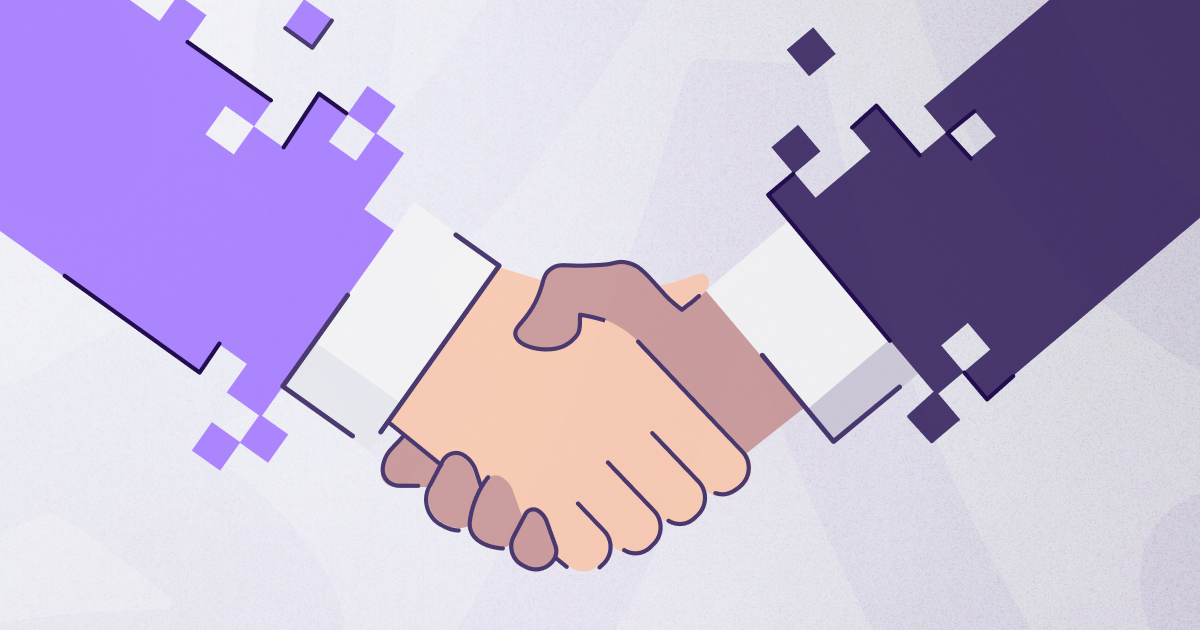
Purchase frequency
Purchase frequency is the average number of times a customer orders from you in a set period.
What is purchase frequency?
Purchase frequency is an eCommerce metric that tells you how often customers buy from you in a set period. Many retailers monitor purchase frequency by quarter and by year. While the expected purchase frequency is different for a pair of shoes than it is for a car, tracking this number enables you to benchmark your performance, identify seasonal patterns, and forecast future sales.
How to calculate purchase frequency
To calculate purchase frequency, determine the time period you want to analyze then use this simple formula:
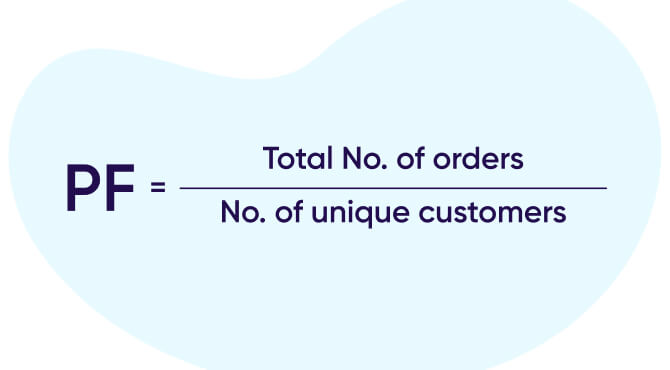
The key here is tracking unique customers, not the total number of customers. For instance, say you have an online pottery shop and processed 50 orders in Q2 from 35 unique customers. 25 customers each made a single purchase, while 10 customers accounted for the remaining 25 orders. In this case, the purchase frequency would come out to 1.43 — in other words, the average customer placed 1.43 orders in Q2.
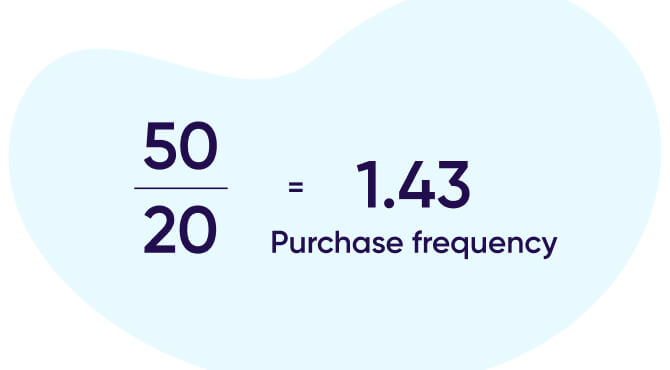
How to track unique customers
Of course, to calculate this number with accuracy, you need a way to identify repeat customers. While this can be difficult in a brick-and-mortar business, it’s easier in eCommerce because you have a built-in way to collect identifying information. As a gold standard, encourage customers to create an account with you to track their purchases.
Even when they use guest checkout, you can add customers to a customer relationship management (CRM) database each time they make a purchase, so you can track unique customers by their email address. Another option is to use AdTech to track online shoppers by their IP address.
If you use point of sale (POS) in addition to eCommerce, encourage customers to enter their phone number, email address, or other identifier to merge your data.
Why is it important to measure purchase frequency?
Purchase frequency is important because it’s a key indicator of customer retention – how often customers return to buy again. Customer retention is a good sign that customers are happy with your products or services and that they’re building buying habits. It’s also far cheaper to incentivize past customers to buy from you than to acquire new ones.
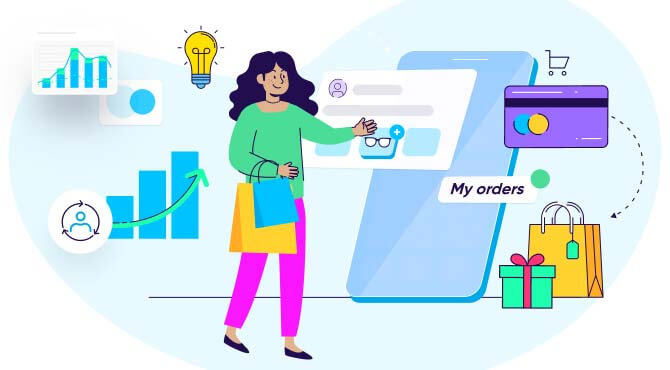
Here are three ways purchase frequency can help your eCommerce business:
1. Understand purchasing behaviors
Do repeat purchases happen at a certain time of year, or on a certain day? Is a particular promotion or marketing channel leading to repeat purchases? Tracking your purchase frequency for different variables like these illuminates patterns to help you understand what’s bringing customers back.
2. Analyze product performance
You can drill down further by measuring the purchase frequency for each product or product category. Identify which products are bringing customers in the “door” to buy again and again so you can put more resources into promoting those products.
3. Boost customer retention and profitability
Once you know your number for purchase frequency (and how it changes throughout the year), you can get to work optimizing it. For example, if you identify a segment of customers with high purchase frequency, you can create loyalty programs or offer personalized discounts for them to encourage repeat purchases. Since customer retention costs less than customer acquisition, this approach can save you money and boost your profits.
Purchase frequency vs repeat purchase rate (RPR)
Another eCommerce metric similar to purchase frequency is repeat purchase rate (RPR). RPR measures what percentage of your customers make a repeat purchase in a set period. Here’s how to calculate it:
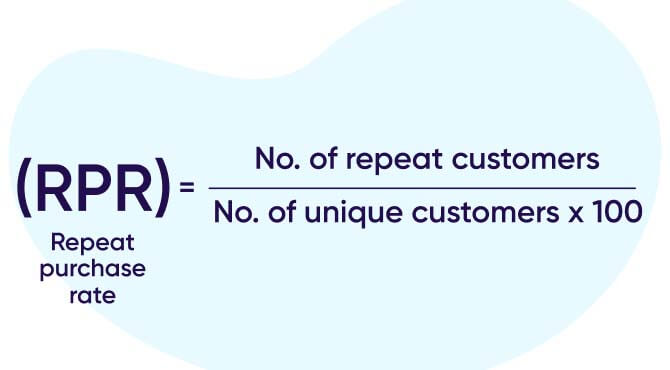
While both metrics measure customer retention, purchase frequency tells you more about the scale of repeat purchases and their potential value.
Let’s say that you’re comparing two online pottery shops. Shop A has a 50% RPR, as half of its customers came back to place a second order that year. Shop B also has a 50% RPR, but has an extra loyal fan base, and returning customers placed an average of three more orders that year. By these metrics, Shop A has a purchase frequency of 1.5, while Shop B has a purchase frequency of 2.5.
What is a good purchase frequency?
As with most things in life, “good” depends on a number of factors. Purchase frequency varies extensively depending on the industry. Purchases like groceries or coffee are frequent and follow weekly or even daily habits. Large purchases like airline tickets, furniture, or a car might happen just once a year or even less – but that doesn’t mean they’re less successful. Mid-line retail items like apparel and gifts often experience seasonal swings.
A study by customer retention platform Beans found the following benchmarks for eCommerce brands by category:
- Books, music, & education: 4.5 (purchase frequency per year)
- Pets: 4.49
- Electronics: 4.17
- Vaping & e-cigarettes: 3.96
- Home & leisure: 3.64
- General goods & supplies: 3.5
- Fashion: 3.25
- Food: 3.12
- Toys & hobbies: 3.04
- Beauty & cosmetics: 2.81
- Sport: 2.46
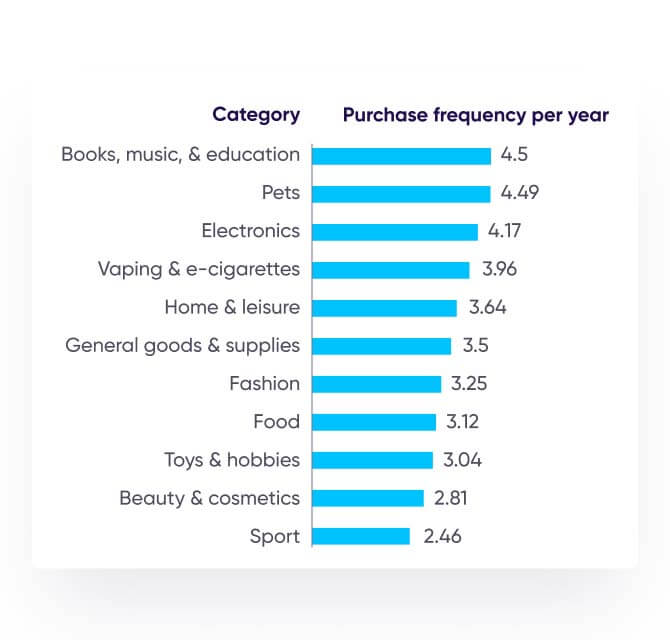
Ways to increase your purchase frequency
Looking for ways to optimize your purchase frequency? Try these five tactics to encourage customers to buy again.
1. Loyalty programs
One way to encourage customers to make more frequent purchases is through loyalty programs. Used by global brands including Marriott, Sephora, Starbucks, and H&M, these programs reward customers for repeat business, often offering exclusive discounts, reward points, or special promotions. By giving incentives for continued purchases, you can nudge customers to buy a familiar brand.
2. Diversified product offerings
When analyzing which products to add to your store, it’s important to consider whether your products are necessities or discretionary items. When offering a necessity like dog food, you’re limited in how frequent your orders will be because dogs only eat so much food. With consumer goods and luxury items like dog toys or clothes, however, you can increase both your order frequency and your average order value (AOV).
Offering basic items can anchor your purchases by bringing customers in to buy what they need; then you can promote add-ons with cross-selling. Basic items are also typically recession-proof: dog owners will continue buying dog food no matter the economic conditions, whereas they might skip the dog costume when budgets are tight.
3. Personalization
Personalization is another powerful tool to increase purchase frequency. With today’s marketing technology and the ability to segment and tag audiences in a CRM, it’s easy to create personalized offers and communications for customers.
Here’s an example: say you sell makeup online and you know the typical bottle of foundation lasts 12 weeks. You can set up an automated email journey to send to buyers 10 weeks after making a purchase with the message, “Running out of X product? Refill today with 10% off”.
By tailoring offers and recommendations based on individual customer preferences and past purchasing behavior, businesses can create a more personalized shopping experience. This not only enhances customer satisfaction but encourages people to buy more frequently.
4. SMS and email marketing
Out of sight, out of mind. When your brand doesn’t stay visible, customers aren’t likely to remember your product and buy again. Retention campaigns through SMS and email are effective at driving repeat purchases through customer engagement.
Create newsletters, social media channels, and SMS campaigns to engage existing customers with your brand. Don’t just make your content about the products: add value to customers with practical tips, customer stories, and videos that will give them a reason to follow along.
5. Subscriptions
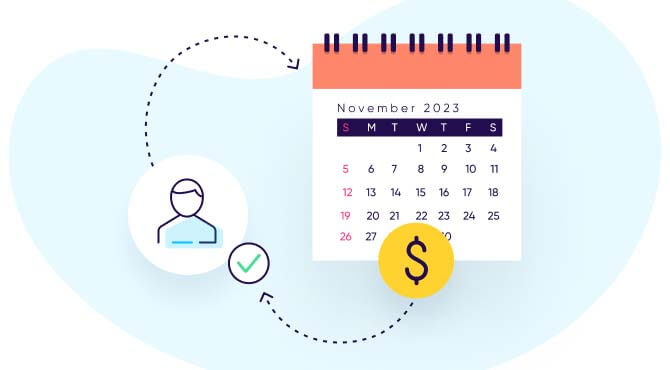
Lastly, subscriptions offer a convenient way for customers to regularly receive products or services they need on a recurring basis. Programs like Amazon Prime Subscribe & Save popularized this approach, and now consumers are embracing subscriptions for everything from coffee beans to craft kits to toilet paper.
The beauty of subscriptions is that once you’ve sold it, it’s essentially passive income: you have a guaranteed number of orders until renewal time. With month-to-month subscriptions, your potential number of orders is unlimited.
By offering subscription options with added benefits such as discounted pricing or exclusive access to new releases, businesses can ensure regular revenue streams while increasing purchase frequency.
Key takeaways
In summary, purchase frequency is an essential metric for eCommerce businesses looking to increase retention and drive growth in today’s competitive market.
Here are the key points to remember:
- Purchase frequency is an indicator of customer retention, a valuable way to grow your revenue without the high price tag of new customer acquisition.
- Measuring your purchase frequency gives you valuable insights into customer behavior and buying patterns throughout the year: knowledge you can use to optimize and grow your sales.
- The typical purchase frequency varies wildly by product category. Frequency tends to be lower for luxury items and apparel, and higher for consumables and essential items.
- Loyalty programs are a great way to track customer behavior and incentivize repeat purchases, while a subscription model ensures a steady income from loyal customers.
- It’s important to offer a range of products, from essentials to discretionary items. When you track purchase frequency for different product categories, you can identify, add, and promote high-frequency products.
- Offers and discounts are a great way to encourage repeat orders. Take your promotions to the next level with personalized offers, and craft SMS or email campaigns to give your customers relevant offers with a VIP feel.

